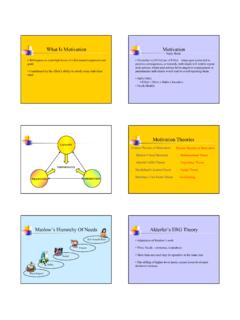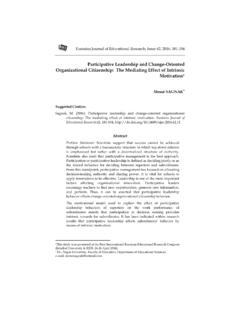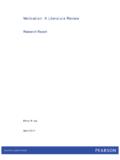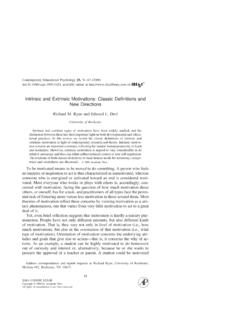Transcription of Impact of intrinsic and extrinsic rewards on employee ...
1 38 The Middle East International Journal for Social Sciences (MEIJSS) e-ISSN: 2682-8766 Vol 2, No 1 Mar. (2020):38-45 Impact of intrinsic and extrinsic rewards on employee performance and determining role of HR practices. A case study of Jordan Raed Walid Al-Smadi Irbid National University, Irbid, Jordan Abstract The aim of the paper was to investigate Impact of intrinsic and extrinsic rewards on employee s performance and determining the mediating effect of HR Practices. The survey was conducted from employees of private organizations in Jordan and 322 responses out of 400 were received from participants. Meanwhile, confirmatory factor analysis (CFA) and PLS-SEM was applied through SmartPLS statistical package.
2 The instrument being used in the survey was tested through Cronbach s alpha, composite reliability, AVE and HTMT ratio; the instrument complies with all of the preliminary requirements of being reliability, valid and is conceptually accurate. Meanwhile, the empirical findings of paper reveal that intrinsic rewards have a positive and statistically significant Impact on the employee s performance but extrinsic have been found to have a positive but not significant Impact on the employee s performance. Meanwhile, the intrinsic rewards and extrinsic rewards also have a direct and significant Impact on the HR practices. On the other hand, indirect effect of HR practices on the effect of intrinsic and extrinsic rewards is also positive and significant.
3 Furthermore, paper also provides recommendations for the organizations in Jordan. Keywords: HR, Employees, Performance, Jordan Introduction In a highly competitive atmosphere firms have been striving to achieve competitive edge through improving products, operational activities and management system in business (Nisar et al., 2014). The ultimate goal of the firm is to achieve pre-planed and scheduled goals and to achieve this employee need to be motivated intrinsically and extrinsically (Kapelner and Chandler, 2010). Similarly, Khan et al., (2014) have stated that rewarding employees and reward system has been one of successful strategies of many organizations to make employees more satisfied, enhance their performance.
4 The satisfaction of employees depends on their thinking, perception and feelings towards job because in a highly work load situation that often arise in every organization requires extra efforts of the employees satisfactorily. This requires an effective and efficient contribution of employees to perform and play a vital role in growth and development of organization (Khan, Yusoff, and Khan, 2014). Therefore, to maintain a healthy and workable environment in high workload situation is critical and this could be achieved through an effective rewarding system within the organization. Hence, this could boost up performance of employees and they could directly contribute growth of organization.
5 39 There are two important components of the employee s performance; one that employees have to be satisfied and second that employees should have positive attitude towards job. The satisfaction and positive job attitude have been associated with the enhanced performance of the employees. However, employee s satisfaction and positive attitude is also linked back with the intrinsic and extrinsic rewards that makes employees to work out of the way (Ajmal et al., 2015). Irrespective of stress in workload situations, they perform exceptionally with hope of reward. However, as per the Qureshi et al (2013) the satisfaction of employees also depends on the practices of human resources management (HR) based on the fact that they prefer to have a fair rewarding system, judges, investigation, neutral performance appraisal and that they should be rewards accordingly.
6 Based on this concept the purpose of following study emerges that if the performance of the employees is enhanced by intrinsic and extrinsic rewards then does HR practices play a role to affect how intrinsic and extrinsic rewards affect employee s performance. The findings of this paper could help to develop strategies to align reward system with the HR practices as to enhance performance of employees. Literature Review A reward is described a benefit received by an individual for performing a specific task or job that enhanced performance and productivity of employee and organization. It is said a reward system in which employees are given benefits based on the job performed and this reward system can be divided into the two categories; intrinsic rewards and extrinsic rewards (Legault, 2016).
7 Meanwhile, the extrinsic rewards refer to the monetary benefits in form of remuneration, commission, improved working environment through separate cabin, opportunities to improve career and also additional benefits and perks for the employees. These are extrinsic rewards that through which employees motivation could be increased towards work (Gerhart and Fang, 2015). Similarly, previous studies have also revealed a that a poor renumeration is associated with the earnings of organization and difference between low income employees and high-income employees makes employees less courageous, less committed and also less productive (Ajmal et al., 2015). Therefore, an effective rewarding system in form of extrinsic rewards could enhance performance of the employees to increased commitment.
8 In addition to, another way to enhance the performance of employees is intrinsic rewards in which employees are given benefits other than monetary rewards . These include appreciation from management, giving an important task, autonomy, promotions, family benefits and also opportunities to increase holidays (Legault, 2016). This allows employees to perform innovatively given that employees are motivated and perceive they are important part of organization and have certain special responsibility towards organization. However, it has also been critically examined by Yoon, Sung and Choi (2015) that reward system does not equally works for all employees where certain employees prefer to have extrinsic rewards most often employees from lower level management and certain employees prefer to have intrinsic rewards most often employees from higher level management.
9 Therefore, distinguishing between those employees is also critical to enhance performance employees rather than demotivating them. Similarly, Ajmal et al (2015) have argued that executives of the organization may not be motivated through extrinsic rewards mean from monetary benefits but they are more likely to prefer intrinsic rewards . It is responsibility of the HR to distinguish between the employees those prefer to have extrinsic rewards and intrinsic rewards and reward them accordingly. The performance management is used a tool by management to improve performance of employees and it has also been revealed by Guest (2017) that productivity of employee is associated with the level of job satisfaction.
10 Employees need to have a better and attractive renumeration packages for high performing employees which could increase employee s satisfaction and commitment towards organization. Similarly, Olsen, Bjaalid and Mikkelsen (2017) found that lower level of job satisfaction is associated with poor performance and as per the theory proposed by the Adams (1963) employees need to be treated equally because they want to be treated equally and fairly. This also reveals that in this way employers can compare the rewards among the employees and avoid inequality but treat everyone equally and reward them as per their role and contribution to specific job or task. Therefore, in absence of proper reward distribution system, the inequality is inevitable and this could also affect the performance of the employees.



